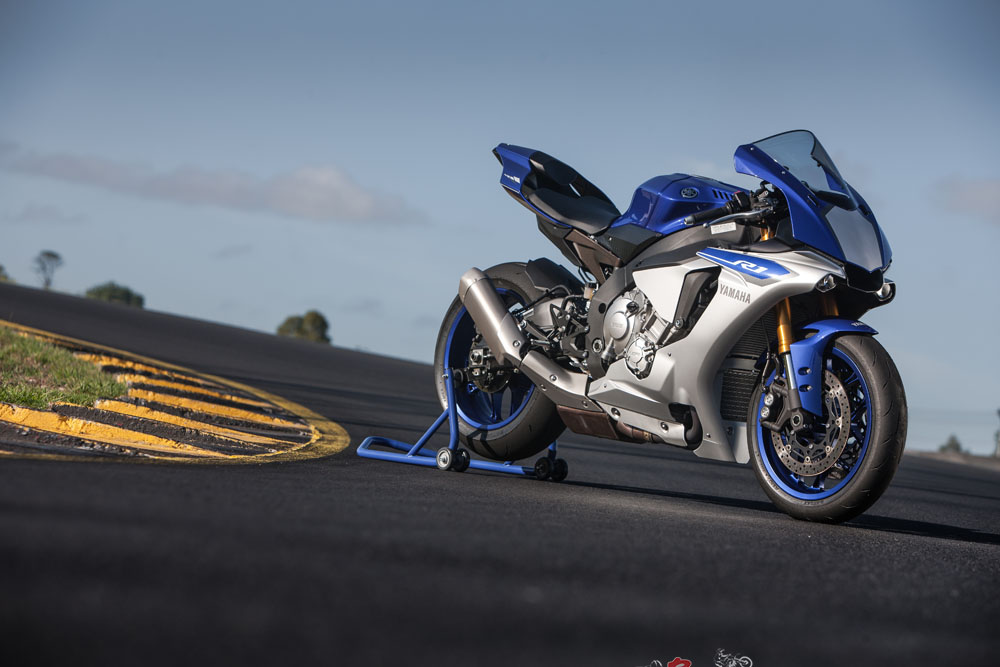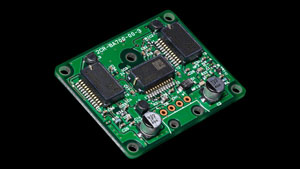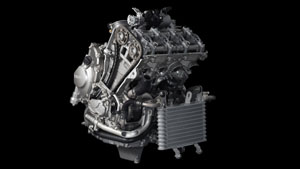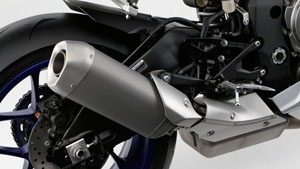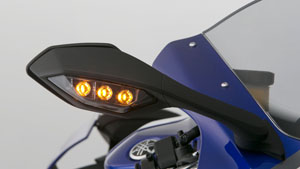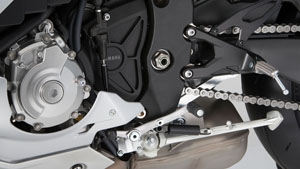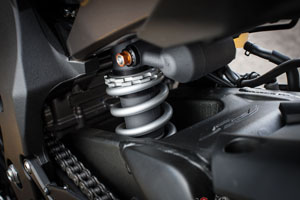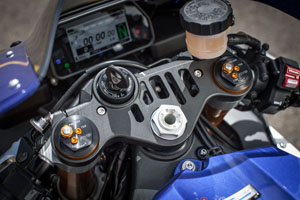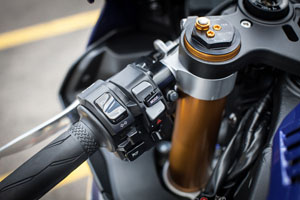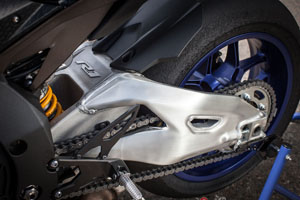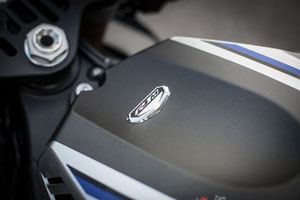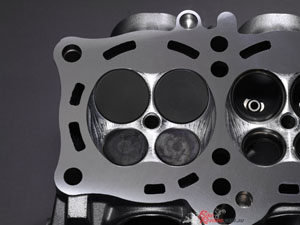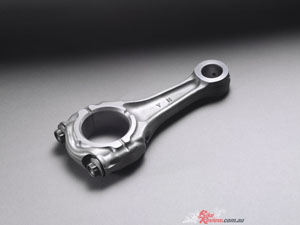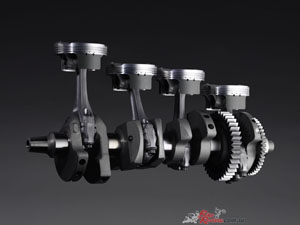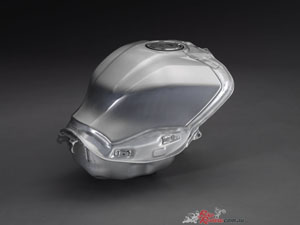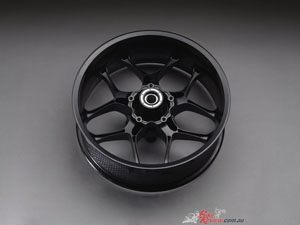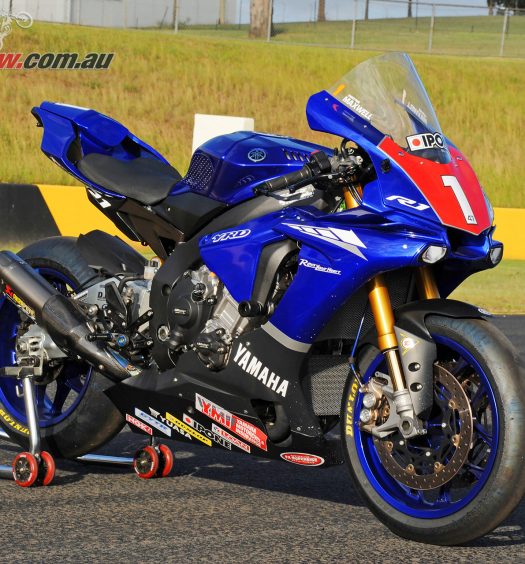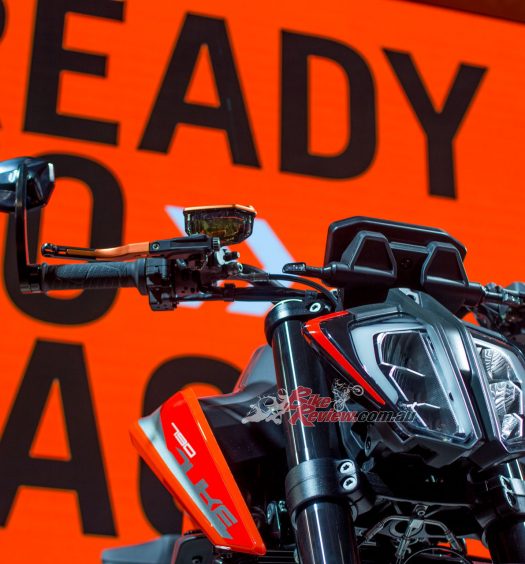Review: 2015 Yamaha YZF-R1 and R1M Track Test
Yamaha's wicked new 2015 YZF-R1 & R1M taken to Sydney Motorsport Park for a full track review... Test by Jeff Ware Photography thanks to Yamaha
It’s fitting that the YZF-R1 was launched at a racetrack. For the third generation in a row, Yamaha chose to conduct the World Press Test of a new R1 model at the Western Sydney SMSP circuit.
The Yamaha staff chose to use the new extended Brabham full circuit – to showcase the handling of the bike in tight sections and fast sections, rather than the more flowing and enjoyable Grand Prix layout.
It tends to be a tricky section of track that extension on any bike but the YZF-R1, which certainly made work easier than any other litre-class bike I’ve ridden there. I could easily have been fooled into thinking I was on the world’s most powerful YZF-R6 such is the diet that the R1 has been on.
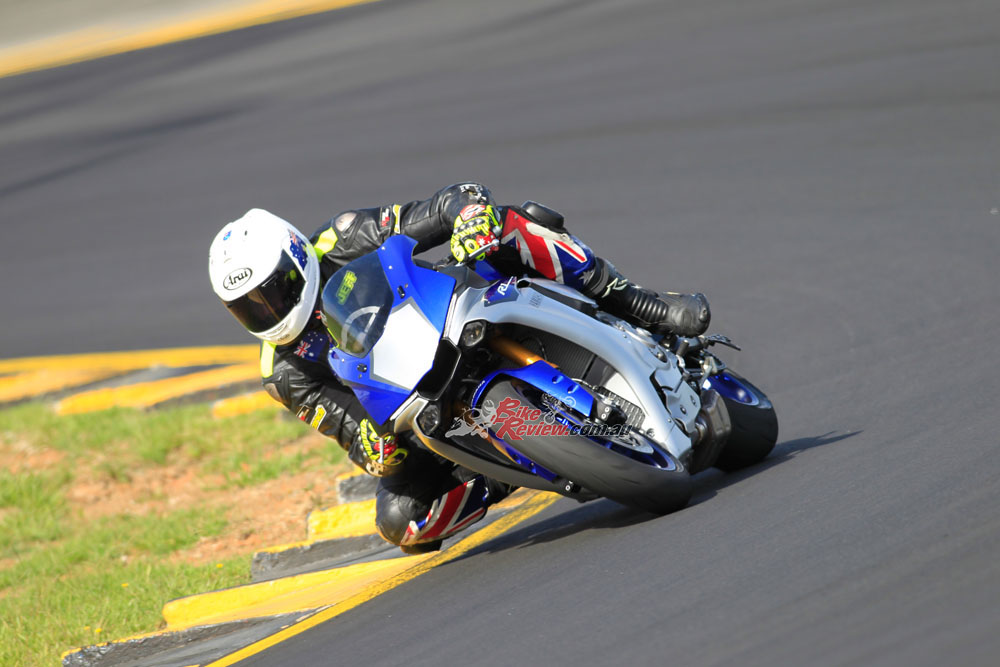 Aside from the name, YZF-R1, there is literally nothing carried forward from the previous generations. Everything is new and so far (no street ride as yet) all improved. For full technical details refer to our breakouts on Engine, Chassis & Styling or Electronics.
Aside from the name, YZF-R1, there is literally nothing carried forward from the previous generations. Everything is new and so far (no street ride as yet) all improved. For full technical details refer to our breakouts on Engine, Chassis & Styling or Electronics.
Developed by Japanese test riders in partnership with AMA star Josh Hayes and MotoGP hero Valentino Rossi, the R1 is very much styled on the M1 and Yamaha have wisely brought over technology from Rossi and Lorenzo’s championship winning machines. It is refreshing to see happen – all that development in MotoGP genuinely landing with the consumer.
There is the stock version, in at $23,499 + ORC as well as a limited edition $29,990 + ORC up-spec M model – more on that later.
I’ve had the pleasure of having lived with four YZF-R1s in the past. I had a 2005 model, followed by a 2007 model then a 2009 big bang and a 2012 big bang. The latter bikes were fantastic street bikes but I never enjoyed them on the track. Heavy means hard work and there was no way out of it – Yamaha had to put the R1 on a radical diet and as soon as I saw the bike in pit lane and sat on it I knew it was going to be fixed…
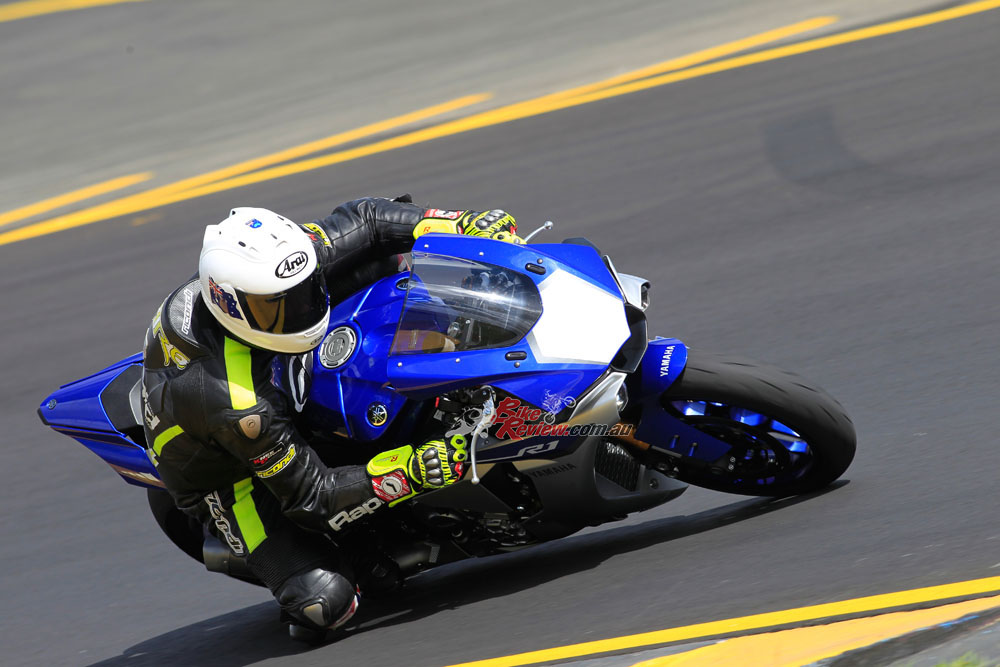 TESTING TIMES
TESTING TIMES
Ergonomically the bike is different to anything I’ve felt. There is no R1 generational familiarity at all.
The reach to the ‘bars is 55mm further now and 10mm longer to the ‘pegs. However, ‘pegs to ‘bars is reduced 5mm. There is plenty of room but I still feel too big for the bike. The fuel tank is low and it almost feels like there is no fuel tank there – making me feel a bit exposed.
The screen is a good size and the dash easy to read at a standstill, with a lot of info to take in.
The seat is great – soft, wide, flat and roomy. The ‘bars are in a position that puts a lot of weight on them. I can’t work out why (I’ve been studying images and still I can’t work out why but it was common feedback among the taller journo’s). The switchblocks are trick with a cool new style click and scroll mouse for menu browsing.
I fire the bike up with the new starter button/kill switch, select first gear and roll out of pit lane. I’ve been riding here for 20-years so that means I am lucky enough to be able to focus on the test rather than which way the track goes.
After the sighting laps it is go time and as I run onto the front chute I twist that YCC-T throttle wide open for the first time. The R1’s acceleration is stunning – the LIF wheelie control stopping the bike getting too high. Seat of the pants dyno it feels like a genuine 185-190-rear-wheel-horsepower bike (note: we were told our bikes ran the Track ECU – no speed limiter and no linked brakes). But it is not the power that impresses and thrills; it is the rapid acceleration that really stands out and above 11,000rpm the bike keeps revving like mad!
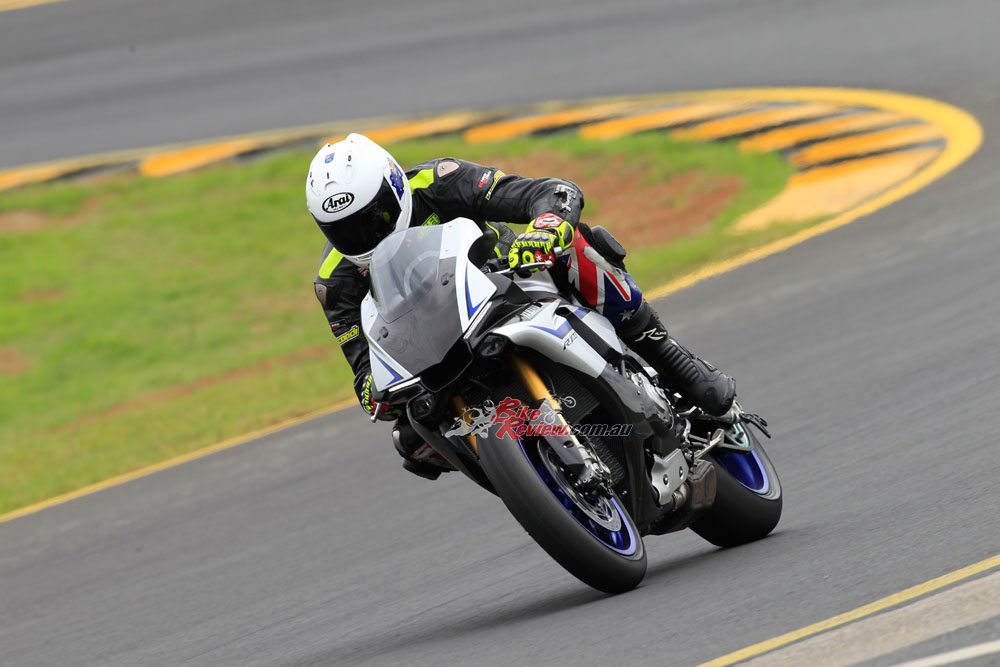 Thanks to high compression, a lightweight crankshaft, titanium conrods, lightweight pistons and a conrod ratio that promotes acceleration this engine revs fast. For a non-pressurized (turbo or supercharged) engine it is amazing how much air it gulps! The gearbox action via the quickshifter is swift and positive and progress forward comes at a rapid rate not unlike that of a real world superbike. In fact, my vote is this is the fastest accelerating production litre-class bike yet. I’m yet to ride the S 1000 RR, new RSV-4 or 1299 Duke though.
Thanks to high compression, a lightweight crankshaft, titanium conrods, lightweight pistons and a conrod ratio that promotes acceleration this engine revs fast. For a non-pressurized (turbo or supercharged) engine it is amazing how much air it gulps! The gearbox action via the quickshifter is swift and positive and progress forward comes at a rapid rate not unlike that of a real world superbike. In fact, my vote is this is the fastest accelerating production litre-class bike yet. I’m yet to ride the S 1000 RR, new RSV-4 or 1299 Duke though.
The bottom-end punch of the older model has gone but the mid-range and top end is incredible. The slipper clutch is brilliant and the bike runs into turns like a two-stroke.
I tried the TCS, SCS, PWR and LIF on 3 across the board for my first session – this was too intrusive so was reduced to 2 across the board, then 1 across the board. I finally settled on 1 for TCS, 1 for SCS, LIF switched off and PWR set to L2, as the throttle was smoother on P2. I did not have time to test launch control, QSS settings or YRC presets. I needed another full day or two to fully explore this – and this test was purely a six-session sample for us journalists.
There were some aspects of the YCC-T that I felt could be improved as I felt I did not have a connection between my throttle hand and the back tyre – the very thing Yamaha engineered into this bike – but can’t judge that fully until I have more time to play with settings to get the throttle/ride connection more natural feeling to give that rider control back. The rest of the rider aids were first class. The TCS very smooth and I did not notice the SCS directly but I do know the rear tyres were really wrecked by the final session and the bike was very loose – however, it just moves around but does not crash. The anti-wheelie I preferred not to use.
Handling was never a strong point for the outgoing R1, which was heavy and bulky with a heavy crank and engine that was low and forward. Not so now…
Steering is fast and accurate on initial turn, the front-end feel is confidence inspiring on the brakes into turns and the bike hooks up and drives off corners incredibly well. Mid-corner the stock standard out of the crate suspension settings were very soft for my 94kg and experience level, not doing the bike any favours but we adjusted that out quite a lot with simple preload and compression and the cornering performance improved.
I would have kept going much firmer had I had more sessions. There was some rear tyre sidewall pump on the gas exiting turns with the RSR10 also. With more time and set-up the potential is there for the bike to be brilliant but with TCS, SCS, LIF, LCS, QSS, PWR and YRC there are endless set-up options and ownership is the only way to explore these.
Braking performance is first rate. Initial bite is strong but very controlled and the lever can be intimately modulated into the turns. I did not feel the ABS at all (Track ECU has a special track ABS setting), however, although the linked brakes were disabled, the rear of the bike would still back into turns on the brakes – without rear brake input from me. More front fork support would help. Easy fix.
Mid-turn corner speed is good but once you crack that throttle make sure you are on line as the bike will fire off with ferocious speed. It’s a deep on the brakes, turn and fire off the corner bike for the modern riding style. Short wheelbase bikes can definitely be fantastic for old school sweeping lines too – as long as the geometry is right – and the R1 is no exception. It just makes more sense to get on the fat part of the tyre and use the amazing engine acceleration and electronics.
Back to the fuel tank size. I use a fuel tank a lot – I place my sternum on the edge of the side of a tank while I corner and brake/corner. I also use my abdominal area help support myself under brakes and my outside arm to support myself during cornering. These points of contact were not accessible for me on the R1, meaning all of my weight was on the ‘bars/my arms. This meant I could not steer smoothly or lock onto the bike and steer with a relaxed upper body.
I noticed a lot of the taller riders who were fast also getting tired on the bike for the very same reason I suspect. Tank grips for the knees might help or sliding the ‘bars down the forks – but then you have the issue of more weight on the front. Not sure what the fix is there but it is something I have never struck before. Bikes are getting too small!
Aside from that – which would not be an issue on the street – I rate the new YZF-R1 a 10/10. It has improved incredibly and set a new benchmark of performance and technology. A true MotoGP bike for the customer. The last time Yamaha gave us a true racer for the road was with the OWO1 and this new YZF-R1 certainly makes me feel it is as special as the OWO1 was…
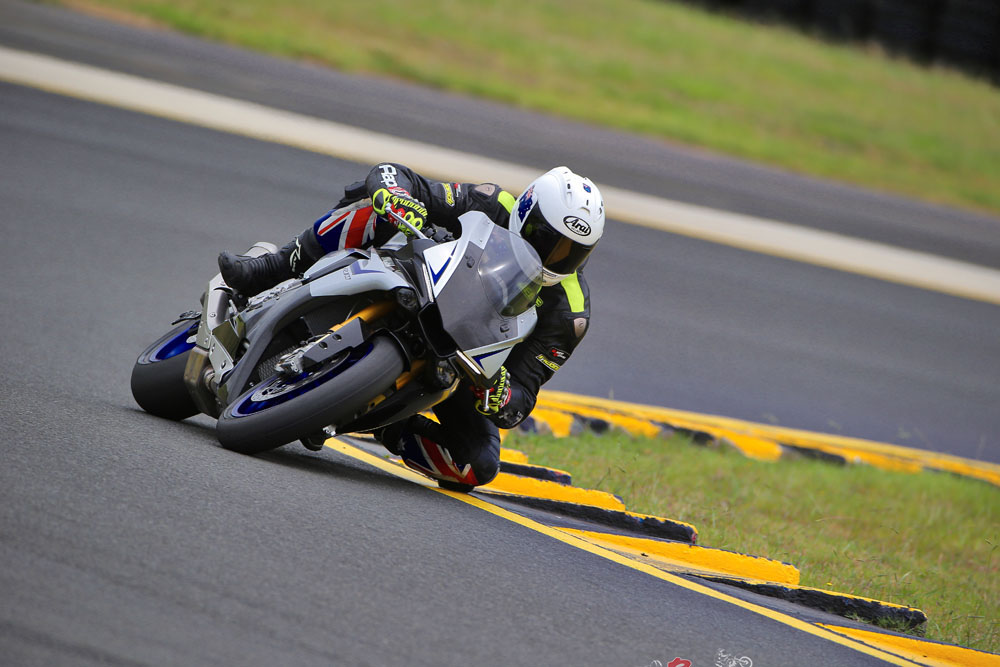 YZF-R1M
YZF-R1M
I rode the YZF-R1M for the afternoon sessions. Before I tell you how amazing it was, I should explain what you get for $29,990 + ORC.
The YZF-R1M is equipped with an hlins Electronic Racing Suspension (ERS) system.
This system takes data from the 6-axis IMU and various sensors, and based on the running conditions the system’s Suspension Control Unit (SCU) makes integrated adjustments to the front and rear suspension.
This new Electronic Racing Suspension (ERS) offers a choice of ‘Automatic’ and ‘Manual’ modes, and within each of these two modes there is a selection of three different settings. The design of the ERS also permits the independent adjustment of the compression and rebound damping functions.
As a genuine ‘factory racer’, the YZF-R1M is equipped with a full carbon fairing, carbon front guard and carbon seat cover. Fitted as standard equipment on the YZF-R1M, the Communication Control Unit (CCU) allows riders to record a wide range of running data, including lap times, speed, throttle position, GPS tracking, lean angle and more. Data can be viewed, compared and shared on a tablet using a wireless connection with the R1’s CCU, enabling riders to analyze the previous race or track session and make any necessary adjustments.
So how does the R1M compare to the R1? First of all the extra grip of the Bridgestone V02 slick tyres made a huge difference and makes it difficult to compare to the bike on treaded tyres. The M also had a larger rear sprocket fitted to compensate for the 200-section tyre but still, gearing was much more suited to the track and first gear was not required.
Ergonomically there is no real difference (5mm seat height) on the bikes but the ride experience is very different. The M is fantastic and much more like a set-up racer or track day bike. The automatic mode on the ERS was fine for me and the firmer fork springs made a huge difference to the bike on the brakes. The rear shock is marginally firmer but I still found it soft in the back – easily adjusted.
Obviously the quality Ohlins suspension makes a difference but I would be interested to try the KYB with the same spring rates as the Ohlins to get a true comparison. The M suspension helped bring out the true potential in the R1 chassis and handling and I was definitely able to push much, much harder on the M. The M would be my choice – and it is more collectible too when it comes to resale value. However, $6k extra is a fair amount of money for most of us. Hmm. Decisions…
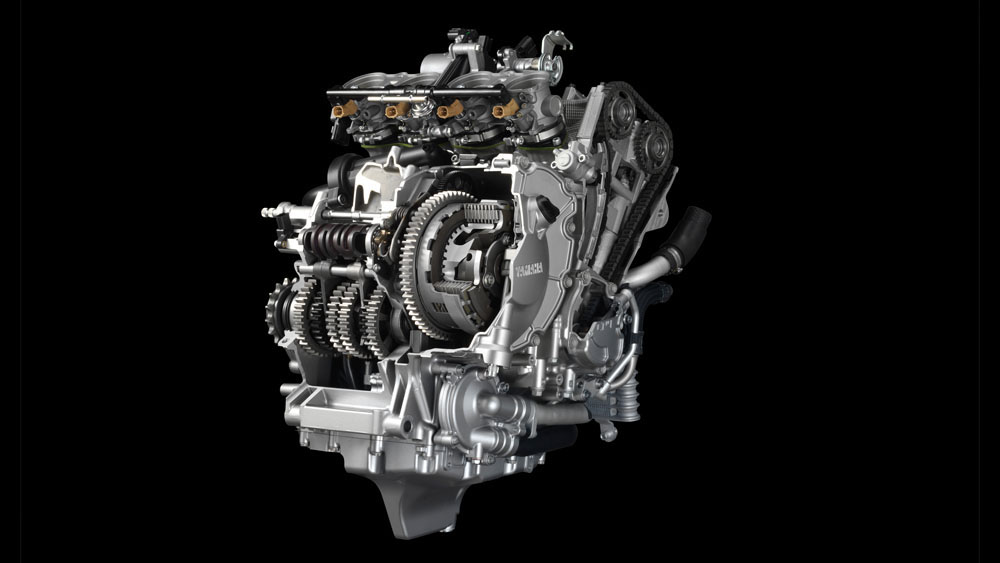 ENGINE
ENGINE
The new R1 crankshaft incorporates a lightweight primary coupling balancer subsequently reducing the inertial moment for strong acceleration and consistently high linear torque levels.
The engine is equipped with a 13.0:1 high compression cylinder-head that features reshaped ports together with large intake and exhaust valves of 33mm(IN) and 26.5mm(EX). Valve angle is narrower to achieve a compact pent roof combustion chamber. The engine features titanium fracture-split connecting rods that are 40 per cent lighter than steel. The fracture-split design also ensures that the big end shape has an extremely high level of circular precision.
Newly designed forged pistons utilize a box-shaped ‘bridge-box’ construction on their underside that gives high levels of rigidity combined with low weight. For the first time in its history, the R1 adopts a new rocker arm valve drive mechanism with a lever ratio that gives a higher valve lift than the cam height, while also decreasing the load on the cam for reduced frictional losses.
A big 10.5L litre airbox is featured. The new R1 is also equipped with a Yamaha Chip Controlled Throttle (YCC-T) operating a newly developed fuel injection system featuring two-directional 12-hole main injectors that direct their high pressure spray at the back of the intake valves. Secondary injectors operate at higher engine speeds and deliver their fuel spray from the upper part of the intake funnel. A newly designed exhaust system is manufactured mainly from titanium.
The new assist and slipper (A&S) clutch has been designed to match the new engine’s high power and torque delivery, and as well as being 19 per cent lighter than the current model’s clutch, its diameter is also reduced by seven per cent.
The new engine uses a centralised method of delivering oil to each individual big end from the end of the crankshaft, resulting in minimal frictional losses. The lightweight magnesium oil pan uses a sunken bottom design that lowers the surface level of the lubricant.
By inhibiting the interference between the crank web and the oil, this design cuts power losses and contributes towards the new R1’s high output.
 CHASSIS
CHASSIS
Featuring gravity cast components that are welded together to form a single structural unit, the compact aluminium main frame offers an ideal balance of strength and rigidity. Weighing in at just 199kg with full oil and fuel and only 179kg dry the R1’s racing DNA is evident in the design and construction of every component.
The new wheelbase is 10mm shorter and the 570mm swingarm is 15mm shorter. Both the caster and fork offset are the same as the current R1 and axle diameter is increased by 3mm to 25mm.
The suspension has been developed by KYB in association with Yamaha. The 43mm forks give 120mm of travel. At the rear end, the newly designed upward-truss swingarm activates a link-type Monocross system.
The R1 is equipped with ABS and also Yamaha’s Unified Brake System.With the Unified Brake System, operation of the front brake also generates a corresponding braking force at the rear and when the rider operates both the front and rear brakes, the Unified Brake System controls the balance of braking force that is applied to each brake.
The new cast magnesium wheels represent a weight saving of nearly 900g. The 17-litre aluminium fuel tank weighs 1.6kg less than an equivalent steel design.
By using aerodynamic analysis to create a more efficient shape, Yamaha’s designers have succeeded in producing a cowl and screen that deliver a reduction of eight per cent in wind resistance. In a further move to achieve a low overall weight, Yamaha’s designers have chosen to equip the new R1 with LED headlights and LED position lights.
The body design of the new R1 has been shaped by the demands of the racetrack, and for this reason Yamaha used their winning MotoGP M1 as inspiration.
One of the most revolutionary design features on the new R1 is its radical new face with a unique ‘headlight-less’ look. In place of the usual twin headlights, this front cowl is equipped with thin and straight LED position lights, while the compact new LED headlights are located within the leading edge of the side cowling.
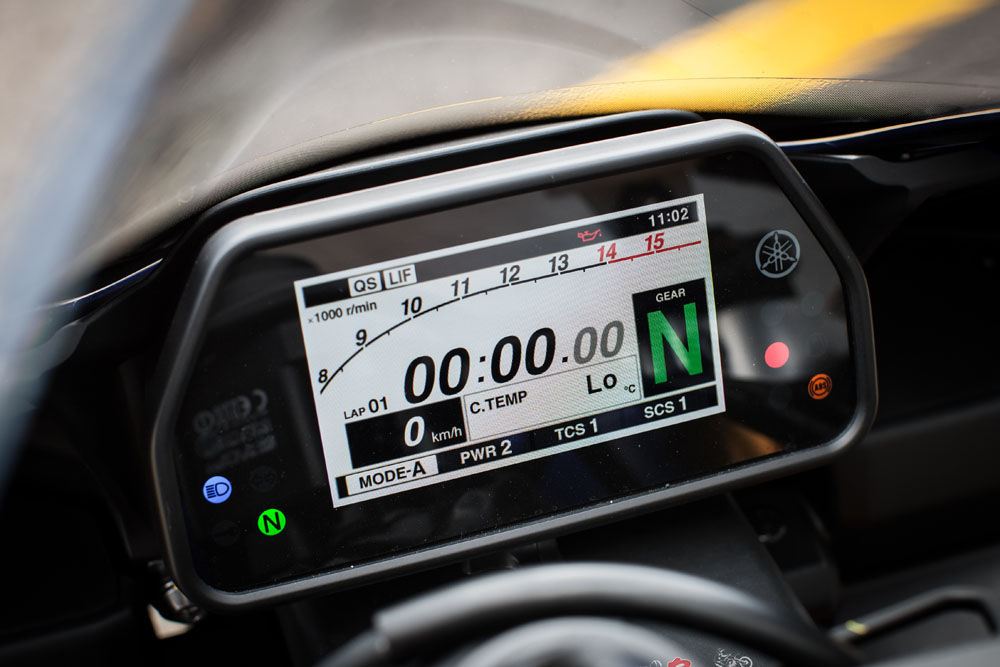 ELECTRONICS
ELECTRONICS
The new R1 is equipped with a highly sophisticated 6-axis Inertial Measurement Unit (IMU) that instantaneously delivers comprehensive machine running data to the ECU.
Developed exclusively for the new R1, this 6-axis IMU consists of three gyro sensors that measures machine pitch, roll and yaw, as well as three G-sensors that transmit data on forward/backward, left/right and up/down acceleration. By constantly analysing this data, the IMU is able to establish the R1’s position and behaviour – including lean angle, slide speed and pitching rate. Data is then sent via a CAN system to the ECU that makes real time calculations and instantly adjusts the R1’s various electronic control systems in order to achieve optimum performance with high levels of controllability.
This in turn has enabled Yamaha to equip this new superbike with the most advanced MotoGP technology, such as a banking angle sensitive rear wheel Slide Control System (SCS) and Traction Control System (TCS).
TCS is able to optimise the drive force to the rear tyre by monitoring the difference in speed between the front and rear wheels, and if it detects that rear wheel traction is being lost, the ECU adjusts the throttle valve opening, fuelling and ignition timing accordingly.
The R1’s newly developed TCS takes the concept to the next level by using additional data relating to the bike’s banking angle when calculating the optimum rear wheel control settings. For example, when the R1 is cornering at a high banking angle, the IMU’s sensors will activate the TCS to a higher level of control than when the motorcycle is upright allowing the R1 rider to achieve optimum performance on a circuit, or whether powering out of a corner or accelerating in a straight line.
Yamaha’s patented Slide Control System (SCS) is designed to limit sidewards movement of the rear tyre by adjusting the engine’s output to an optimal level via the ECU when a slide is detected.
The third weapon in the R1’s control armory is its LIFt control system (LIF) that has been developed to control front wheel lift when accelerating hard.
For fast, smooth and efficient starts, the Launch Control System (LCS) restricts engine rpm to below 10,000rpm even at full throttle. This control system also uses information from the TCS and LIF systems in order to maintain an optimum level of engine output when accelerating away from the start line, allowing the rider to concentrate fully on the crucial first few seconds of any race. The Quick Shift System (QSS) gives seamless upshifts.
The newly developed Power mode selection (PWR) gives the option to choose from a selection of four different adjustable running modes.
The YRC offers four grouped presets for quick and simple ‘one-click’ selection of all electronic controls through easy handlebar switches. In the (YRC) each of thecontrol modes can be freely adjusted into new combinations based on user preferences and riding environment.
With its wide array of electronic controls, the new R1 produces a mass of information and Yamaha have developed an effective new rider-machine interface that conveys the data in a clear and intuitive manner.
The dash can be set to either ‘Street’ or ‘Track’ mode with a choice of a black or white background. In ‘Street’ mode the display features items such as gear position, while the tachometer bar display uses different colours as the revs increase, allowing the rider to instantly comprehend the data. Other items available in ‘Street’ mode include odometer, tripmeters, real-time fuel efficiency, average fuel efficiency and amount of fuel consumed.
In ‘Track’ mode the display shows specific information with a high degree of clarity, such as lap number, lap times and a stopwatch function. The bar type tachometer display starts at 8000rpm and runs to the red line, and the gearposition indicator is prominently displayed to the right of the panel.
SPECIFICATIONS: 2015 Yamaha YZF-R1 (M spec’s in brackets)
PRICE: $23,499 ($29,999) + ORC
WARRANTY: Two-year/unlimited kilometre
COLOURS: Blue and Silver, Red and White, (Black/Black and Silver)
CLAIMED POWER: 147.1kW[200hp]@13500rpm
CLAIMED TORQUE: 112.4Nm[82.9ft-lbs]@11500rpm
CLAIMED WET WEIGHT: 199kg (200kg)
ENGINE: Liquid-cooled, four-stroke, crossplane forward-inclined parallel four-cylinder, four-valve per cylinder, DOHC, 79 x 50.8mm bore x stroke, 998cc, 13.0:1 compression, banking sensitive TCS/SCS, LIF, LCS, QSS, PWR power modes, YCC-I, YCC-T, six-axis IMU, (CCU), magnesium oil pan, titanium four-into-two-into-one exhaust
GEARBOX: Constant mesh, six-speed
CLUTCH: Assist and Slipper clutch, wet, multiple-disc
CHASSIS: Aluminium Deltabox frame, aluminium upward-truss swingarm, magnesium sub-frame, Rake: 24, Trail: 102mm
SUSPENSION: 43mm KYB fully adjustable telescopic forks, KYB rear shock, (Ohlins Electronic Racing Suspension forks and rear shock)
BRAKES: Banking sensitive Racing ABS, Unified Brake System, dual 320mm front rotors, dual monobloc four-piston calipers, 220mm rear rotor, single-piston pin-slide caliper
WHEELS & TYRES: Cast magnesium 10-spoke wheels, 120/70 – 17 (f), 190/55 – 17 (r) (200/55 ZR17), Bridgestone RS10 (Bridgestone V02 slicks)
DIMENSIONS:
Seat height: 855mm (860mm)
Overall height: 1150mm
Overall length: 2055mm
Width: 690mm
Wheelbase: 1405mm
INSTRUMENTS: TFT LCD display


